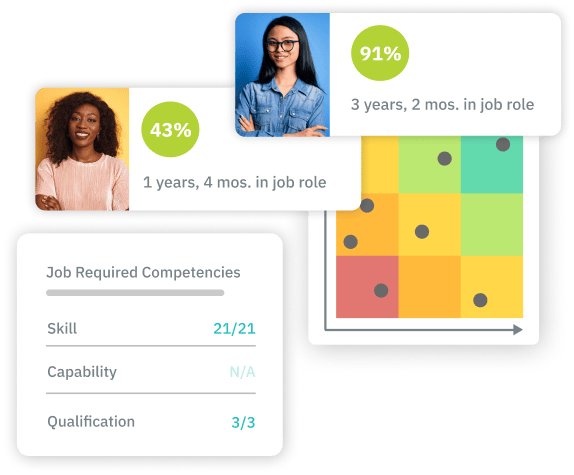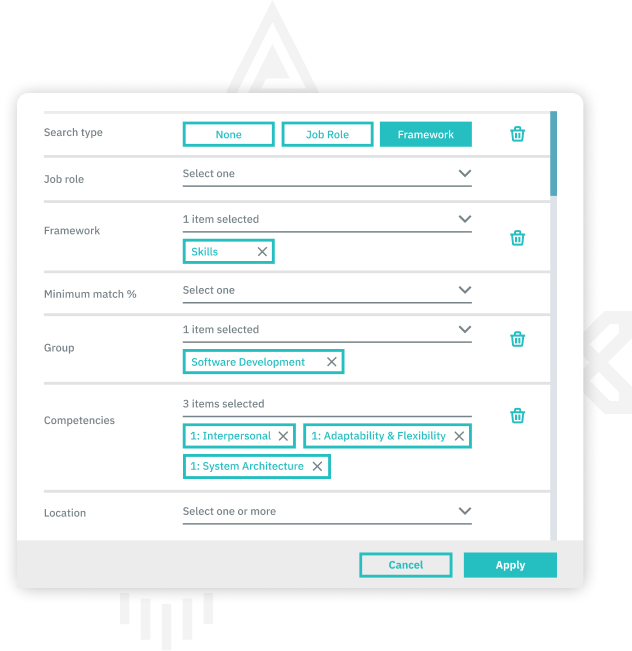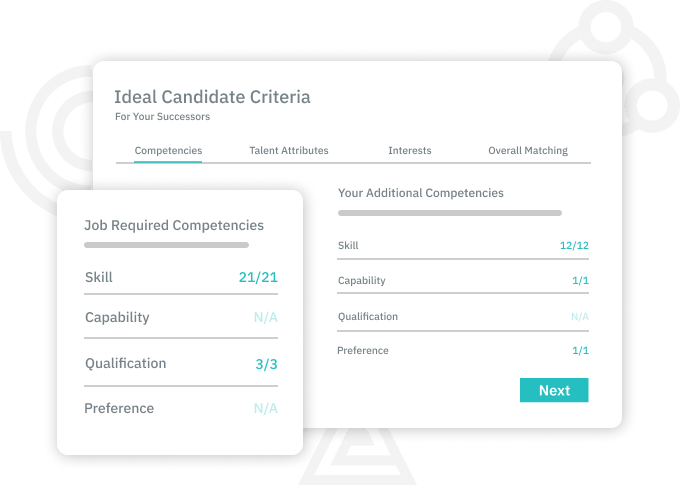Succession Planning Software
See the future by planning for it
Predict the company’s future talent needs and choose the best candidates for the most important roles, based on a complete view of your company’s collective talent.

Succession Planning Software
Succession planning software is a vital tool for organizations looking to manage their talent effectively. An efficient succession planning toolkit offers several benefits, including identifying potential successors for critical positions, providing guidance for leadership development, and managing career progression for employees. With the increasing demand for succession planning in talent management strategies, succession planning technology has emerged as a critical element for organizations.
Succession planning software offers automated and integrated solutions that help organizations build a strong pipeline of future leaders and maintain business continuity. The software provides real-time tracking of employee performance, identification of skill gaps, and a comprehensive view of critical vacancies. Additionally, these tools provide insightful analytics to help organizations make informed strategic decisions about the future of their workforce. By adopting succession planning software, organizations can ensure that their talent management practices are curated and consistently managed, paving the way for long-term success.
For businesses, having a succession plan in place is essential for long-term success. Without it, companies are at risk of losing key personnel or being unable to fill important positions when they become vacant. Succession planning software is an invaluable tool for businesses, allowing them to create a plan that will ensure continuity and prepare them for any eventuality. It provides the resources and guidance needed to develop effective plans that can be easily adapted as business needs change over time.
Moreover, the software integrates seamlessly with other TalentGuard modules, such as Performance Management and 360 Feedback, creating a comprehensive talent management ecosystem. This integration ensures that all aspects of an employee’s development are aligned and that data is consistently updated across the platform.

Talent pool builder
Proactively manage succession risks and role vacancies with internal talent pools. Evaluate how well candidates match the role profile and alert management to flight risks.

Targeted internal talent search
Recruit internally based on multiple criteria, including verified skills, competencies, performance, career aspirations, manager recommendations, and more.

Objective candidate evaluation
Reduce bias in your internal mobility decisions with objective, verified skill data. Compare candidates side-by-side based on match percentage, time-to-readiness, previous roles, preferences, and more.

A clear view of future needs
Enable managers to see their teams’ bench strengths, tenure risks, and gaps in role succession so they can develop their people with an eye to the future.

Ideal candidate finder
Wish you could find someone just like your top performer? Use this flexible tool to define the skills, experiences, and other characteristics of your ideal candidate and find internal talent that matches.
See How Our Platform Helps You Build a Future-Ready Workforce
TalentGuard works best with organizations of 500+ employees in the U.S., Europe, Latin America, and regions within six hours of Central U.S.
Every company is at a different stage. Some need to clean up messy job titles and skills first. Others are focused on readiness, mobility, or succession.
Our bundles are built to match those realities. Pick the bundle that’s closest to where you are today, and we’ll tailor the demo to your needs. If you’re unsure whether we serve your region or use case, email info@talentguard.com and we’ll help you find the best fit.
Automate
Competency management for HR with AI automation. Create AI-powered skills, jobs, and career paths, building a strong talent management foundation.
Automate includes:
- WorkforceGPT Copilot powered by Generative AI
- Talent Frameworks: Access to industry-specific pre-built competency models
- Content Management System: Ability to create, edit, manage and map skills, jobs, learning and career progressions.
- Workflow and Approvals Automation
Engage
Enhance employee engagement and retention with impactful strategies that ensure optimal return on investment.
Everything in Automate plus:
- Talent Assessment: Assess employee skills and competencies
- Development Plan: Develop personalized learning paths
- Career Path: Advance employees with recommend career paths
- Analytics: Workforce intelligence insights and reporting
Optimize
Build a robust enterprise foundation to manage and optimize your mission-critical talent management program at scale.
Everything in Engage plus:
- Succession Planning: Build high-potential talent pools
- Performance Management: Review, set goals, & provide feedback
- Certification Tracking: Track employee certifications
- 360 Feedback: Conduct multi-rater leadership feedback
Trusted by Leading Companies Worldwide




Your Workforce is Evolving — Be Ready for What’s Next
Read our eBook
What is Succession Planning?
Succession planning is a strategic process that ensures the continuity of critical positions within an organization. It is a comprehensive and ongoing process that involves identifying and developing potential successors for key positions in an organization. The primary goal of succession planning is to identify and develop high-potential employees to fill critical positions when the current occupant vacates the position, either due to retirement, promotion, or unforeseen circumstances. Succession planning goals examples may include ensuring a smooth transition of leadership, maintaining organizational stability, and achieving long-term growth and success. Leadership succession planning is a critical aspect of succession planning that focuses on identifying and developing potential leaders within an organization. There are several types of succession planning, including contingency planning, short-term and long-term planning, and strategic planning. Some succession planning examples include Microsoft’s transition from Bill Gates to Steve Ballmer, and Apple’s transition from Steve Jobs to Tim Cook. Properly executed succession planning can help an organization retain institutional knowledge, maintain stability, and ensure continued growth and success.
Succession Planning Process
Succession planning is an essential process for organizations looking to ensure a smooth and efficient transition of leadership within their ranks. It involves identifying and developing internal employees, who have the potential to take on key positions within the organization. The objectives of succession planning are to maintain business continuity by filling critical positions with qualified candidates and to develop internal talent to prepare for future roles. Succession planning best practices include developing a clear succession planning framework, which outlines the roles and responsibilities of key stakeholders involved in the process. The 4 stages of succession planning namely, assessment, development, readiness, and transition, form the foundation of a successful succession plan. During the assessment phase, employees are evaluated in terms of their skills, experience, and career aspirations. The development phase involves providing targeted training and development opportunities to high-potential employees, while the readiness phase focuses on preparing them for their new roles. The final stage involves implementing the succession plan, ensuring that the incoming leaders are welcomed and integrated into their new roles. Overall, the succession planning process is an important tool for any organization seeking to manage its talent effectively and prepare for the future.
Why Succession Planning is Important
Succession planning is a crucial component of efficient business management, and plays a crucial role in ensuring the long-term sustainability of an organization. It seeks to identify and develop the next generation of leaders, while at the same time ensuring that key strategic positions within the organization are not left vacant or filled by employees that are not adequately qualified. Succession planning minimizes the risks of disruption that result from the unexpected departure of key employees, such as retirements, resignations, or education opportunities, and ensures that the organization remains stable and productive.
The benefits of succession planning are numerous, and include better and more reliable leadership, cost savings from reduced turnover and reinvestment in employee recruitment and training, and enhanced productivity through the alignment of talent with the organization’s mission and goals. This process also helps to maintain a strong corporate culture, as the organization’s values and practices are handed down to future generations of employees. In order to build a robust succession plan, organizations need to take a proactive approach that includes regular assessments of talent, clear guidelines regarding job responsibilities and expectations, and effective communication of company goals and objectives. With the help of sound succession planning, businesses can not only weather internal turbulence, but they can also thrive and grow into the future.
Succession Planning Framework
Succession planning is an important part of any organization, as it ensures that the right personnel are in place to carry out critical roles and responsibilities. A succession planning framework is a set of best practices, processes and procedures that organizations use to identify high-potential employees, groom them for leadership roles, and create a pipeline of talent.
The goal of a succession planning framework is to mitigate the risks and disruptions associated with sudden changes in personnel. It allows for thoughtful, proactive decisions about which employees should be promoted or otherwise groomed for more advanced positions. This helps organizations maintain a level of stability and continuity as they transition between leaders.
The first step of a succession planning framework is talent identification. Organizations need to identify those employees with the greatest potential to fill future roles. This usually involves assessments such as interviews, personality tests, and performance evaluations. Once they have identified their high-potential talent, organizations need to groom them for leadership positions by providing development opportunities such as mentoring programs, specialized training, and job rotation.
The final step is succession planning. Here, organizations can create a pipeline of talent that allows them to make informed decisions about who is best suited for future roles. By taking a proactive approach, organizations can ensure they have the right people in place when needed and minimize disruptions caused by sudden changes in personnel.
Succession planning is essential for any organization looking to maintain stability and continuity as it transitions between leaders. A sound succession planning framework can help organizations identify and groom high-potential talent for future roles, create a pipeline of talent that allows them to make informed decisions about who is best suited for the job, and minimize disruptions caused by sudden changes in personnel. In today’s business climate, creating an effective succession plan is essential for organizational success.
Furthermore, a succession planning framework also allows organizations to identify positions that may not need to be filled. This helps them allocate resources more efficiently and focus on developing their best talent. It also encourages employees by showing them that there is a clear path for advancement within the organization, which can help increase job satisfaction and retention rates.
How do I create a succession plan?
Succession planning is an important part of any business’s long-term growth and development. It ensures that key roles are filled with the right people, sets organizational goals, and helps ensure a smooth transition when personnel changes or retirements occur. The process requires careful consideration of skills, experience, and knowledge needed to fill each role in the future as well as the right people to fill them.
Creating a succession plan starts with identifying key roles that need to be filled in the future and determining who is best suited for each role. This means understanding the current personnel’s skills, experience, and knowledge base as well as what they will need to succeed in their role in the future. It also requires an understanding of potential future roles and what skills, experience, and knowledge base will be needed to fill them. Next, it is important to develop a plan for developing existing personnel to ensure they are well-prepared for their future roles. This includes training and development opportunities as well as mentoring programs.
Finally, software can be used to facilitate succession planning. There are many different software solutions available to help businesses identify, develop, and track key personnel. These solutions typically include features such as skill assessment and development planning tools, succession planning templates, and reporting capabilities to help organizations easily manage the process. By leveraging these types of software solutions, businesses can more effectively create comprehensive succession plans that will ensure that their future roles are filled with the right people at the right time.
Succession planning is an important part of any business’s long-term strategy and should be done regularly to ensure that key roles are filled with the right people, organizational goals are set, and smooth transitions occur when personnel changes or retirements take place. With careful consideration, effective development plans, and software solutions for facilitating the process, businesses can create comprehensive succession plans to ensure their long-term success.
Help future-proof your workforce with succession planning.
Organizations that want to remain competitive must look beyond short-term hiring and focus on building long-term talent pipelines. A strong succession planning platform helps HR leaders prepare for future leadership needs while reducing risks from unexpected vacancies. Companies create an agile and future-ready workforce by identifying high-potential employees early and nurturing their growth.
The best succession planning software doesn’t just track names in a spreadsheet — it offers analytics, talent mapping, and readiness assessments that give leaders confidence in their bench strength. With real-time insights, companies can anticipate skill gaps before they become a problem and take proactive steps to close them. This forward-looking approach ensures business continuity and helps organizations thrive in a fast-changing market.
Create coverage plans for key roles.
Every organization has critical roles that cannot afford to sit vacant. Succession planning systems make it possible to create detailed coverage plans for these positions, outlining who is next in line and what development they need to step up when the time comes. This ensures leadership transitions are seamless and operations are not disrupted.
A well-designed succession planning tool goes beyond replacement charts. It provides visibility into career paths, competency levels, and leadership readiness so managers can make informed decisions. With the right tools for succession planning, companies can align talent development with business priorities and keep their most essential positions secure.
Help employees see their future with you.
Employees want to know they have a future at your company. When organizations invest in a succession planning platform, they send a powerful signal that career growth is a priority. Employees can see how their skills connect to future opportunities, which drives engagement and retention.
Modern succession planning software solutions allow employees to explore potential roles, access learning resources, and build personalized development plans. By giving workers a clear view of their possible career paths, businesses can reduce turnover and foster a culture of growth. This transparency not only boosts morale but also strengthens the internal talent pipeline.
Find the right replacement faster.
When a critical role becomes vacant, speed matters. Succession management software enables organizations to quickly identify the best candidates from within the company, using data-driven insights rather than guesswork. This reduces the time-to-fill for high-level positions and ensures continuity of leadership.
A robust succession software solution also helps minimize bias in promotion decisions. By comparing employees’ skills, performance, and readiness, HR teams can evaluate candidates objectively and confidently select the right leader. This faster, fairer process benefits both the business and its employees.
Prepare for what’s next with succession software.
No company can predict the future, but the right succession planning software solutions make it easier to prepare for change. Whether leaders step down after a planned retirement or exit unexpectedly, companies that use succession planning tools are ready to act quickly and confidently. These solutions give leaders insight into talent pipelines, highlight potential turnover risks, and identify the development needed to cover critical positions.
By using advanced succession planning systems, organizations can make well-considered talent decisions instead of reacting on the fly. This preparedness keeps transitions smooth, protects day-to-day operations, and builds trust between employees and leadership.. Choosing a dependable succession planning tool today ensures your workforce is ready for whatever challenges tomorrow may bring.
Why our customers love TalentGuard
Customers choose TalentGuard because we deliver more than just software — we provide peace of mind. Our succession planning platform integrates seamlessly with performance management, career pathing, and skills development, ensuring that all aspects of employee growth are aligned. This unified approach gives leaders the insights they need to make informed decisions at every stage of succession.
Clients also appreciate how our solution balances simplicity with power. TalentGuard provides the best succession planning software experience by offering intuitive dashboards, automated reporting, and flexible tools that scale with your business. With TalentGuard, organizations know their future is secure because they have the right people prepared for the right roles at the right time.


